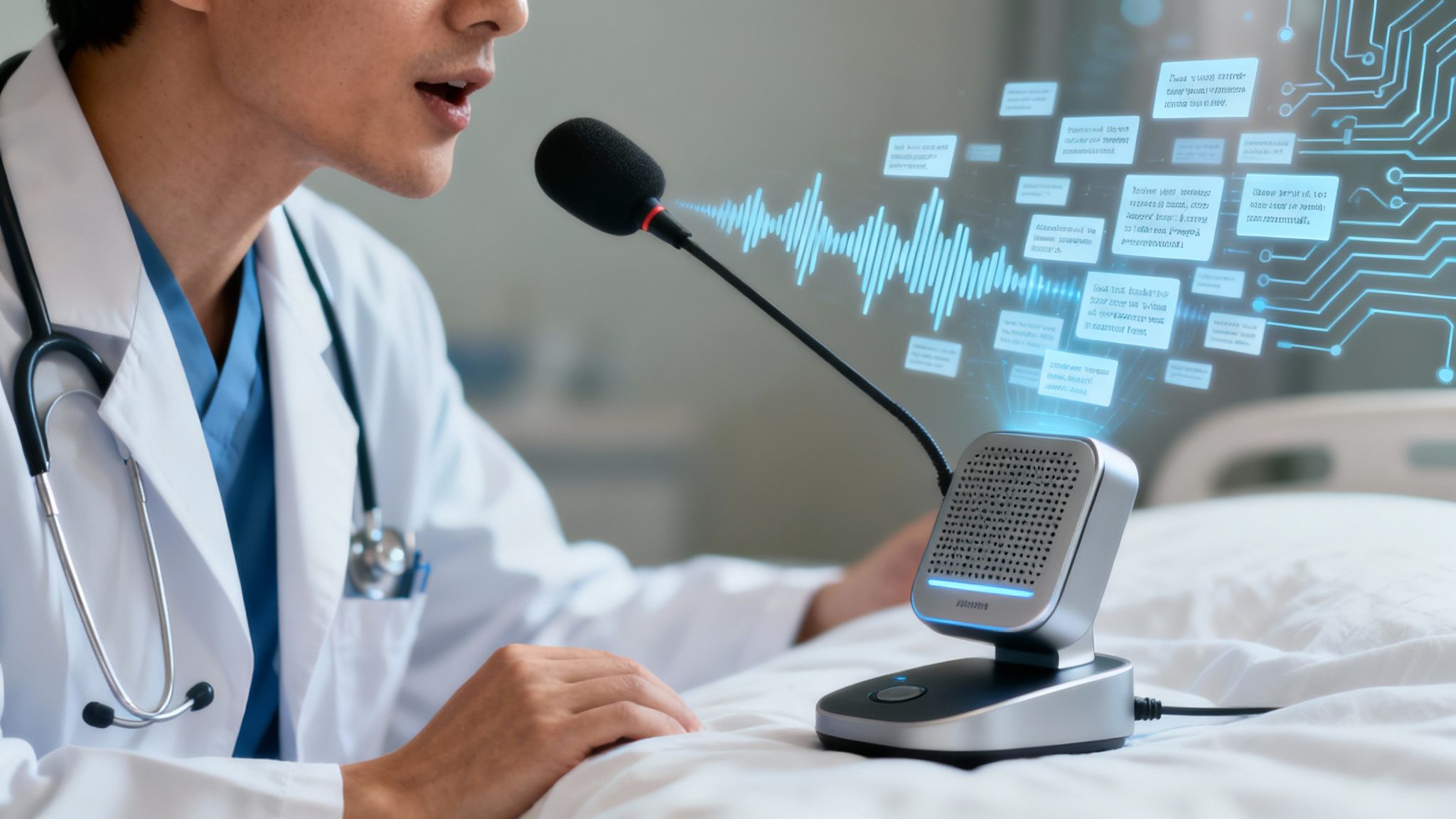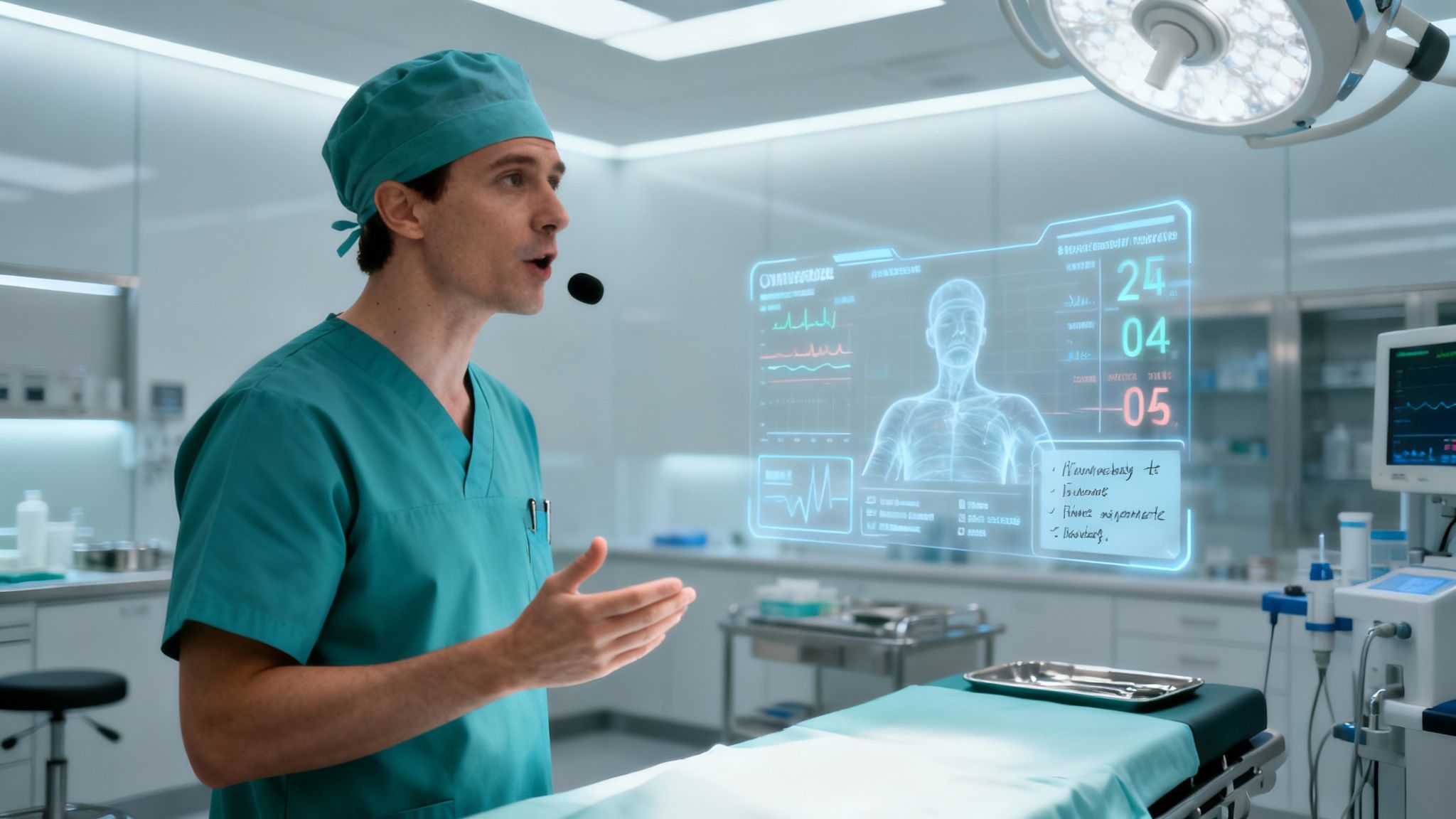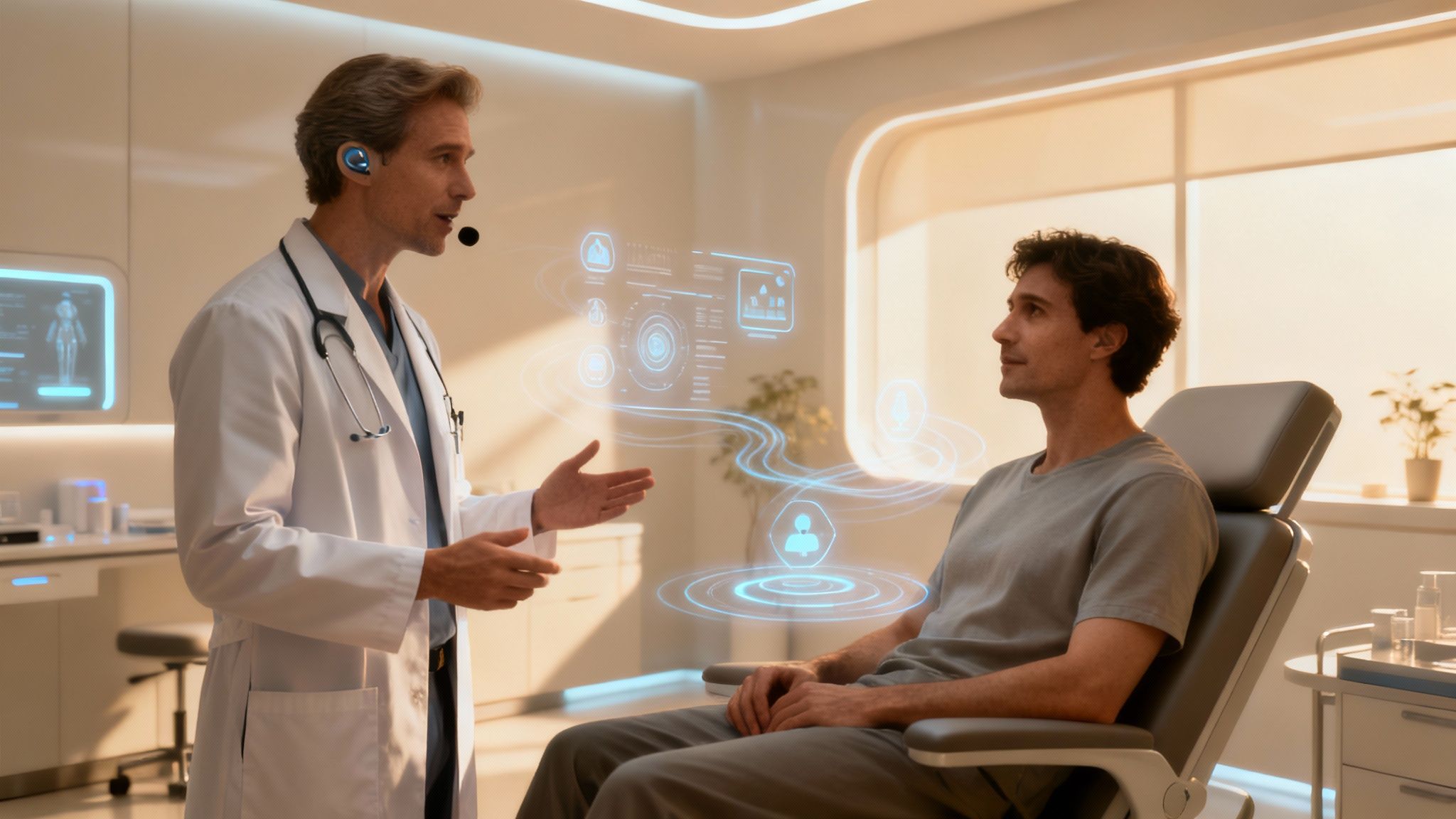Picture a doctor's visit where the physician is completely focused on you, not a computer screen. That’s the simple, powerful promise of voice technology in healthcare. It’s about moving beyond basic dictation and into a world where smart AI listens, understands the context of a medical conversation, and turns it into useful, structured data. This comprehensive guide will explore how this technology works, its real-world applications, tangible benefits, and what the future holds for this transformative field.
This shift is just as significant as when medicine moved from paper charts to electronic health records (EHRs). It directly tackles one of the biggest sources of physician burnout today: the mountain of administrative work and documentation. By automating the note-taking, voice technology lets doctors be doctors again, not data clerks, fundamentally changing the dynamic of patient care for the better. This guide will serve as your deep dive into understanding this revolutionary change.

From Niche Idea to Mainstream Tool
What felt like a futuristic concept just a few years ago is quickly becoming a standard part of modern medicine. The relentless need for more efficiency has poured fuel on this fire, turning a small niche into a massive industry. The demand for hands-free, accurate, and rapid data entry has never been higher, and voice technology is perfectly positioned to meet that demand.
In fact, the global market for healthcare voice tech was already valued at $5.06 billion and is expected to skyrocket to $21.67 billion by 2032. That’s a compound annual growth rate (CAGR) of 19.9%, a clear sign that this technology isn't just a trend—it's here to stay and is a core component of digital health transformation strategies worldwide.
Bringing the Human Connection Back to Healthcare
When you get down to it, this is really about making medicine more human. When doctors are drowning in paperwork, the patient-provider connection is the first thing to suffer. That administrative weight doesn't just burn out good clinicians; it pulls their attention away from the person sitting right in front of them, leading to what is often called "distracted doctoring."
By capturing the conversation as it happens, these systems allow for more present, empathetic patient care. The tech does its job quietly in the background, so no critical detail is missed and the natural flow of the appointment isn't broken.
This has a ripple effect across the entire healthcare experience:
- Less Admin Overload: Clinicians using voice AI get a huge chunk of their day back, freeing them up to think critically and connect with patients. This reduction in "pajama time" spent on charts is a significant boost to morale and work-life balance.
- Better, Cleaner Notes: AI systems capture information with incredible accuracy, cutting down on the errors that can happen with manual typing and rushed notes. This leads to higher-quality data for clinical decision-making, billing, and population health initiatives.
- A Better Patient Visit: Patients feel seen and heard when their doctor can look them in the eye instead of staring at a screen. This improved engagement can lead to better adherence to treatment plans and higher patient satisfaction scores.
Tools like an AI-powered medical scribe are becoming indispensable, translating a natural patient conversation directly into a perfect, structured clinical note within the EHR. It’s all about making healthcare more efficient and, most importantly, more personal and effective.
How a Conversation Becomes Clinical Data

It seems almost like magic when a doctor's words from a patient visit appear as a perfectly organized note in the chart. But what's happening behind the scenes isn't magic at all. It's a sophisticated, multi-step process that translates human conversation into structured, usable clinical data. Understanding this process is key to appreciating the power and reliability of the technology.
This entire journey is powered by two foundational pillars of voice technology in healthcare: Automatic Speech Recognition (ASR) and Natural Language Processing (NLP). These two technologies work in tandem to hear, interpret, and structure the spoken word.
First up is ASR. Think of it as the system’s dedicated set of ears. Its sole job is to listen carefully to everything being said and turn those sound waves into written text. At this stage, it's just a raw transcript—words on a page, without any inherent meaning or structure. ASR for healthcare must be specifically trained on medical jargon, accents, and the noisy reality of a clinical setting to be effective.
But a simple transcript is just the beginning. It lacks context and can't tell the difference between a patient's current symptom and their family's medical history. That's where the real intelligence kicks in, moving beyond simple transcription to true comprehension.
The Brain Behind the Voice
If ASR provides the ears, then Natural Language Processing (NLP) is the brain. NLP takes that raw text and gets to work making sense of it. This is what elevates the technology from a simple dictation tool to a truly smart clinical assistant. NLP algorithms are trained to understand grammar, syntax, context, and, most importantly, clinical intent.
For example, imagine a doctor says, "Patient reports chest pain but there is no sign of MI his uncle had an MI last year."
An ASR system just writes that sentence down. But a healthcare-trained NLP model can dissect it with incredible precision. It knows "chest pain" is the patient's current symptom and belongs in the "History of Present Illness" section. It also understands that "MI" means myocardial infarction and correctly links it to the uncle's history, not the patient's, placing it in the "Family History" section.
This is the key difference. The system doesn't just hear words; it understands clinical intent, context, and relationships. This ensures the right data goes into the right field in the Electronic Health Record (EHR), maintaining data integrity and utility.
This technology is the reverse of what’s covered in an ultimate guide to Text-to-Speech technology, which explains how text is turned back into spoken words, but they're two sides of the same coin, both essential to creating a seamless human-computer interface.
A Real-World Clinical Scenario
So, what does this look like during an actual patient visit? The whole process is designed to be seamless, letting the doctor and patient talk naturally without interruption, a concept often referred to as "ambient clinical intelligence."
-
Capturing the Conversation: As the doctor and patient talk, a secure, ambient listening device or a simple app on a phone captures the audio. The system is smart enough to tell who is speaking—the doctor, the patient, or even a family member in the room—using a technique called diarization.
-
Instant Transcription: In real-time, the audio is sent to the ASR engine. This isn't just any speech-to-text model; it's one specially trained on a massive library of medical terms, from complex drug names to obscure anatomical references. This training is crucial for accurately catching complex drug names, procedures, and acronyms that a standard ASR would fumble.
-
Understanding and Structuring: Next, the NLP engine takes over. It scans the transcript, identifying and pulling out key clinical concepts. It then sorts them into standard medical note categories—things like the chief complaint, history of present illness, symptoms, medications, allergies, and the doctor's final assessment and plan.
-
Populating the EHR: Finally, this neatly structured data is sent directly to the EHR, automatically filling in the relevant fields to build a complete clinical note. All the physician has to do is give it a quick review and sign off, often saving several minutes of manual data entry per patient.
This entire sequence, from a spoken word to a structured EHR entry, happens in a matter of seconds. As this overview of AI medical transcription explains, these systems are built for accuracy and speed, even in the chaos of a busy clinic. This is how voice technology in healthcare gives clinicians back their time and lifts the heavy burden of administrative work.
Putting Voice Technology to Work in Healthcare

It's one thing to talk about the theory behind voice technology in healthcare, but where the rubber really meets the road is in the day-to-day work of clinicians and their staff. This is where we see the technology making a real, tangible difference, both on the clinical frontlines and in the back office, transforming workflows that have been static for decades.
On the clinical side, voice tools are tackling some of the oldest frustrations in medicine: inefficiency, documentation overload, and even patient safety. Think about a surgeon in a sterile operating room. They can't just step away to type on a keyboard or scroll through a patient's chart with contaminated gloves.
With voice commands, that same surgeon can instantly call up imaging ("Show me the pre-op CT scan"), check vitals ("What's the current blood pressure?"), or dictate procedural notes ("Begin incision at 10:42 AM") without ever breaking sterile protocol. This isn't just a nice-to-have; it's a fundamental improvement in how care is delivered in high-stakes environments.
The same goes for a routine exam. A doctor can ask the system to pull up the latest bloodwork ("Show me the patient's A1C from last month") while maintaining eye contact with the patient. It keeps the conversation flowing and the focus exactly where it should be: on the person in front of them.
A Smarter Way to Handle Clinical Notes
One of the most impressive applications we're seeing is something called ambient clinical intelligence. Picture an AI system that listens quietly during a patient visit. It’s smart enough to understand the conversation, pick out the important clinical details, and draft the visit note automatically in the background.
This frees the doctor to be fully present with their patient, building that crucial human connection, all while knowing the tedious documentation is being handled in the background. The physician's role shifts from data entry clerk back to that of a healer and diagnostician.
This tech is bringing the focus of the exam room back to human care, not data entry. Clinicians are reporting it saves them an average of five minutes per encounter, which is a huge win in fighting off burnout and can translate to seeing more patients or spending more quality time with each one.
The shift toward voice is happening everywhere. In fact, more than 50% of the world’s population will soon use voice search daily, and there are nearly 8 billion voice assistants in use globally. As people get comfortable talking to devices at home, they expect similar convenience and efficiency from their healthcare providers.
Automating the Administrative Grind
The power of voice extends well beyond the exam room. Administrative work, while absolutely necessary, eats up a massive amount of time and can create serious bottlenecks in any practice. These tasks are often repetitive and ripe for automation.
Voice AI is now automating many of these repetitive jobs, which means the front-office team can focus on patients with more complex needs, such as insurance verification or coordinating specialist appointments. A perfect example is the virtual medical receptionist, a system that can manage calls 24/7.
Here are a few ways voice AI is changing the administrative game:
- Smarter Scheduling: Patients can book or change appointments by simply talking to an automated assistant, either over the phone or through a website chatbot. The system checks the clinic’s real-time calendar and offers open slots, ending the frustrating game of phone tag.
- Automatic Prescription Refills: For routine refills, a voice system can securely handle the request, verify the patient’s information through a series of questions, and send it to the pharmacy—all without a human needing to touch it.
- Reminder and Follow-Up Calls: AI-powered calls can remind patients about appointments or provide care instructions after a visit. This simple step is proven to cut down on no-shows and help patients stick to their treatment plans, improving outcomes.
These tools don’t just make the office run smoother. They give patients instant access to basic services anytime, which is exactly what they’ve come to expect in a digital-first world.
Voice-Enabled Workflows vs Traditional Methods
When you put the old manual processes side-by-side with new voice-automated workflows, the difference is striking. By taking over these routine tasks, voice technology in healthcare creates real, measurable time savings and lets skilled staff focus on what matters most: complex problem-solving and patient interaction.
| Task | Traditional Method (Average Time) | Voice-Enabled Method (Average Time) | Key Benefit |
|---|---|---|---|
| Documenting a Patient Visit | 10-15 minutes of manual typing | 2-3 minutes of review and sign-off | Reduces clinician burnout and increases patient face time. |
| Scheduling an Appointment | 5-8 minutes per call | 1-2 minutes of automated interaction | Frees up front-desk staff and eliminates patient hold times. |
| Processing a Refill Request | 3-5 minutes of staff time | Less than 1 minute of automated processing | Improves pharmacy turnaround time and reduces errors. |
| Retrieving Patient Labs | 1-2 minutes of EHR navigation | 10-15 seconds via voice command | Allows clinicians to access data without interrupting care. |
Ultimately, this shift results in a more efficient, less stressful environment for everyone involved—from the front desk to the operating room. It's a clear win for productivity, staff satisfaction, and the bottom line.
The Measurable Benefits for Patients and Providers
When you’re thinking about bringing any new technology into a healthcare setting, the first question is always: "What's the return on investment?" With voice technology, the benefits aren't just hypotheticals on a spreadsheet. We're seeing real, measurable results for everyone involved—from the clinicians on the front lines to the administrators managing the bottom line, and most importantly, the patients themselves.
These advantages really boil down to three key things: massive efficiency gains, better accuracy and safety, and a human impact that’s bringing the focus back to the patient-provider relationship. These aren't mutually exclusive; they create a virtuous cycle where each benefit reinforces the others.
The financial and operational arguments are getting harder and harder to ignore. The market for conversational AI in healthcare is expected to rocket from $17.2 billion in 2025 to a massive $169.5 billion by 2035. That kind of explosive growth tells you one thing: this technology delivers tangible value. You can explore the full market projections to get a sense of just how big this shift is.
Boosting Clinical and Administrative Efficiency
The most immediate win with voice AI is simple: it gives you back time. Ask any clinician, and they’ll tell you about the "pajama time" they spend finishing notes long after the last patient has left. Voice technology goes right after that problem, directly targeting the documentation burden.
Instead of typing, clinicians can have a natural conversation, and the system automatically transcribes and organizes the clinical notes. We've seen studies showing that doctors can save an average of five minutes per patient encounter. That might not sound like much, but for a busy doctor seeing 20 patients a day, that adds up to over an hour and a half of reclaimed time every single day. That’s more time to see patients, collaborate with colleagues, or just get home at a reasonable hour.
This isn't just a win for clinicians; the front office sees the benefits, too:
- Lighter Phone Lines: Automated voice systems can handle the routine stuff—like scheduling appointments or processing refill requests—which frees up staff to focus on patients with more complex needs. This can reduce call abandonment rates and improve patient satisfaction.
- Quicker Access to Information: A doctor can just ask, "Show me the latest lab results for Jane Doe," instead of clicking through a dozen screens in the EHR. This micro-efficiency adds up, making every interaction smoother.
- Smoother Workflows: Everyday tasks like sending off a prescription or generating a referral letter can be automated with simple voice commands, cutting down on the endless clicking and administrative drag that slows down the entire care delivery process.
Enhancing Accuracy and Patient Safety
Let's be honest, human error is a factor in any manual process. In healthcare, a simple typo in a medication dosage, a misremembered detail from a patient’s history, or a transcription error can have devastating consequences.
Voice AI acts as a critical safety net here. It captures every word accurately during a consultation, making sure the clinical record is complete and precise. These systems are trained on vast medical dictionaries, so they nail the spelling of complex drug names and conditions that are easy to fumble when you're typing in a hurry. The result is a cleaner, more reliable medical record.
By creating a complete and accurate record of the patient encounter, voice technology builds a stronger foundation for clinical decision-making. It ensures that every provider who accesses the patient’s chart has a clear, unambiguous understanding of their condition and treatment plan, reducing the risk of medical errors.
This all leads to a much safer environment for patient care, one where the risk of miscommunication or data entry errors is dramatically reduced. This improved data quality also has downstream benefits for research, public health, and quality reporting.
Reducing Burnout and Restoring the Human Connection
This might be the most important benefit of all. Clinician burnout is a full-blown crisis, and a huge part of it is the soul-crushing administrative burden that pulls doctors and nurses away from what they signed up to do: care for people.
When you take the keyboard out of the equation, the entire dynamic in the exam room shifts. The doctor can look the patient in the eye. They can listen with their full attention and have a real conversation. This doesn't just make patients feel better—a recent study found 93% of patients reported a better overall visit—it also gives clinicians their sense of purpose back.
By taking on the documentation grunt work, voice technology in healthcare directly fights the fatigue and emotional exhaustion plaguing the industry. In fact, 70% of clinicians who use these systems say they feel less burned out. This is about more than just making work easier; it's about making the practice of medicine more fulfilling and sustainable for the very people we depend on.
Navigating the Common Implementation Hurdles
Let's be realistic: bringing any new technology into a healthcare setting is a major undertaking. Voice technology is no different. The potential payoff is huge, but getting there means carefully navigating a few common roadblocks. A successful rollout isn’t about just buying software; it's about a smart, comprehensive strategy that anticipates the unique challenges of a clinical environment.
By thinking through these hurdles from the get-go—security, integration, adoption, and accuracy—you can make sure your investment in voice technology actually delivers on its promise to improve care, lighten the load on your staff, and make operations run smoother.
Getting Data Security and HIPAA Compliance Right
The second a system comes near patient data, security has to be priority number one. Protected Health Information (PHI) is incredibly sensitive, so any voice tool you consider must be absolutely ironclad when it comes to HIPAA regulations. This is non-negotiable. It means all audio and transcribed text must be encrypted, both as it travels over your network (in transit) and when it's stored on servers (at rest).
But true security goes beyond just encryption. You need a system with fine-grained access controls, ensuring only authorized individuals can access specific patient records. Robust audit logs are also essential, tracking every time data is accessed or modified.
Here's a critical piece of advice: never, ever partner with a technology vendor that won’t sign a Business Associate Agreement (BAA). This is the legal contract that holds them accountable for protecting PHI to HIPAA standards. No BAA, no deal. It's a fundamental requirement for any third-party handling patient data.
Integrating with Your Existing EHR
One of the first questions everyone asks is, "How will this work with our current EHR?" Nobody wants another isolated piece of software that creates more work and traps data in a silo. For voice technology in healthcare to be truly effective, it has to feel like it belongs, integrating smoothly with the systems your team already relies on every day.
Look for a solution designed for interoperability. Modern systems use standards like Fast Healthcare Interoperability Resources (FHIR) APIs to create a seamless, two-way street for information. This allows the voice tool to not only push structured notes into the EHR but also pull relevant patient data out, giving clinicians the context they need without having to switch between applications.
When it works right, the voice tool feels like a natural part of the EHR, not some clunky, bolted-on accessory. This deep integration is the difference between a tool that saves time and one that creates new headaches.
Winning Over Your Staff: Training and Adoption
You can have the most brilliant technology in the world, but it's worthless if your team doesn't use it. Clinicians are already juggling a dozen things at once and are understandably wary of anything that might disrupt their flow. That’s why your implementation plan needs to put user training and support front and center. Change management is just as important as the technology itself.
A great way to start is with a pilot program. Find a small group of enthusiastic clinicians—your "super users"—to test it out first. Their feedback is gold for fine-tuning workflows, and their success stories will be your best marketing tool for getting everyone else on board.
Your training needs to be practical and show people exactly how this tool will make their day easier. A few things that work well are:
- Hands-On Workshops: Let people play with the system in a safe, simulated environment. It builds confidence and reduces anxiety about making mistakes.
- Cheat Sheets: Create simple, one-page guides for the most common voice commands they'll need.
- Ongoing Help: Make it crystal clear who to call or message for help when they have a question or run into a snag after launch. Accessible, responsive support is key to long-term adoption.
Mastering Accuracy in a Messy, Noisy World
A chaotic emergency room or a busy clinic hallway is not a recording studio. One of the biggest technical tests for any voice system is whether it can accurately pick up a conversation with phones ringing, people talking in the background, and constant interruptions. It also has to be smart enough to understand different accents, dialects, and the variable pace at which people talk.
This is where the quality of the AI really shows. Modern voice models are specifically trained for these tough conditions. They use sophisticated algorithms like noise cancellation and speaker diarization to filter out the noise and are built on massive, diverse datasets to understand all the ways people speak.
When you're evaluating a system, insist on a demo in one of your own noisy environments. See how it performs under pressure with real-world clinical conversations. This is the only way to know if a particular voice technology in healthcare is tough enough for the reality of your clinic.
The Future of Voice in Connected Healthcare

If you think voice technology in healthcare is impressive now, just wait. We're really only scratching the surface. Today, we're focused on chipping away at documentation and administrative tasks, but the real magic is just around the corner: a truly connected, predictive, and proactive system of care powered by voice.
We're about to move past simple dictation and into an era of intelligent, ambient systems that are practically invisible, acting as a constant, helpful presence in both clinical and home settings. The technology will become more intuitive, integrated, and indispensable.
The Rise of the Invisible Assistant
The next major leap forward is something called ambient clinical intelligence. Picture an exam room where the technology just fades into the background. An AI-powered system listens in on the natural, free-flowing conversation between a doctor and a patient, picking out the important clinical details, and not only drafting notes automatically but also teeing up relevant orders for labs, imaging, or prescriptions—no specific commands needed.
Think of it as an invisible partner in the room. It frees the clinician to focus completely on the patient, building rapport and trust, while knowing that every critical detail is being captured accurately and translated into actionable next steps. This isn't just about saving time; it's about making the clinical environment more human again and augmenting the clinician's capabilities in real-time.
A More Connected Patient Journey
The future of voice also reaches far beyond the four walls of the clinic. It's about weaving this technology into a patient's everyday life, connecting with telehealth platforms, remote patient monitoring tools, and wearable devices to create a constant feedback loop for monitoring and support.
This opens up some incredible possibilities for proactive care and chronic disease management:
- Wearable Integration: Imagine a patient's smartwatch detects an abnormal heart rhythm. A voice assistant on their phone could immediately ask about their symptoms ("I see your heart rate is elevated. Are you feeling dizzy or short of breath?") and even offer to schedule a telehealth visit on the spot if their answers warrant it.
- Proactive Health Management: At home, a voice assistant could gently remind an elderly patient to take their medication, ask them to log their blood pressure reading for the day by simply speaking it aloud, or walk them through post-op care instructions in a conversational manner. This technology could also analyze a patient's tone of voice for signs of depression or cognitive decline over time.
This kind of interconnected system shifts healthcare from a series of disconnected appointments to a continuous, supportive conversation. It gives patients the tools to take a more active role in their own health and provides clinicians with a much clearer, real-time picture of what's happening between visits, enabling earlier interventions.
For a deeper dive into how this is changing user interaction across the board, it's worth reading up on the rise of voice-activated interfaces and the new doors they open for accessibility and convenience.
Ultimately, voice is becoming the connective tissue for a smarter, more responsive, and patient-first healthcare system. It's not just another efficiency tool—it’s the key to making healthcare feel more personal, data-informed, and seamlessly integrated into our daily lives. The journey has just begun, and the potential to revolutionize patient care is immense.
Ready to bring the future of voice automation to your practice? Simbie AI offers clinically-trained voice agents that handle patient intake, scheduling, and more, 24/7. Discover how you can reduce administrative overhead by up to 60% and free your staff to focus on patient care. Visit https://www.simbie.ai to learn more.

